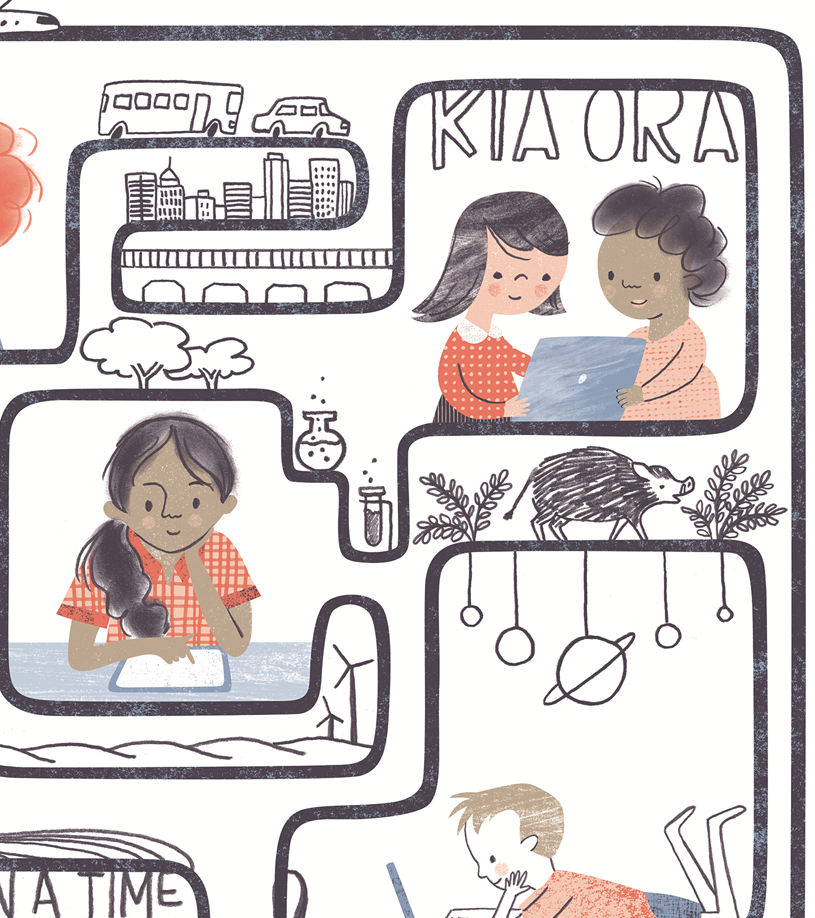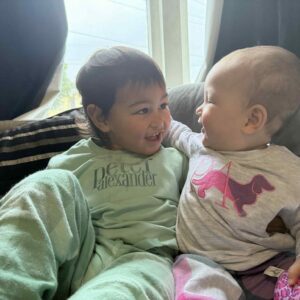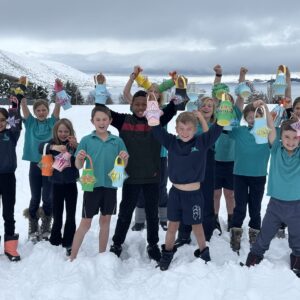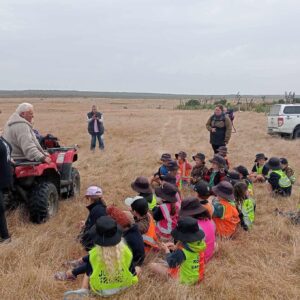From the grounds of Halfmoon Bay School you can watch the fishing boats come in. Twice a day, the tourists come too, attracted to Rakiura National Park and a simpler, slower lifestyle governed by rhythms of sea and tide. There are 33 students at the school, up from 2015, when the community ran an advertising campaign to attract more families to Stewart Island. A couple of extra students meant the school could keep its second teacher.
Kath Johnson, who is principal here, knows all about the precariousness of small schools. For 12 years she’s worked hard, with her parent community and some rural teaching colleagues, to mitigate the worst aspects of remoteness. The result has been the creation of a vibrant and varied learning programme at Halfmoon Bay School, much of it built around online communities.
“We’ve got kids here learning visual art from specialist teachers, kids doing digitech, extension maths and programming. There are students learning German, French, Mandarin and Spanish,” says Johnson.
“All the learning opportunities that they might get in a big city school, our kids are getting – while also experiencing the best of what a small school can offer.”
“All the learning opportunities that they might get in a big city school, our kids are getting – while also experiencing the best of what a small school can offer.”
Kath Johnson
Their online learning is sourced through two separate but linked communities: the Rural and Remote Network, a co-operative of rural schools, and the Virtual Learning Network (VLN) Primary School, a charitable trust governed and resourced by participating schools and, in part, the Ministry of Education.
The Rural and Remote Network began at a sole-charge principals’ conference in 2011. A bunch of principals got together, talked about ways to address problems of isolation and came up with a plan.
“As a starter, we thought it would be cool if we could organise a camp for our senior kids,” says Johnson, who was the instigator of the group. “We knew it would be good for our kids to spend time with a larger group of students their own age. Out of that grew an online class, initially to prepare for camp, but then to teach other things and build a community.”
Teachers volunteered to teach across the community. Soon, Year 7 and 8 students were getting together online for novel studies, poetry and social studies units. They learned about each others’ lives and shared stories.
“It’s been great to see our older students developing relationships with other kids their age. They get to know each other online and then at camp, which we now hold every two years. It’s become a very important part of school tradition.”
Leo de Beurs, principal at Kaitoke School on Great Barrier Island, agrees. “The classes and camp help prepare our senior students for high school. Most of our Year 7 and 8 [students] have never been in a big group of kids their own age. They’re used to being the big people in a classroom of younger children, some of whom might be family members. They also get to work with other teachers, with different personalities and teaching styles.”

On remote Pitt Island in the Chatham Islands, principal Rick Whalley spent two years building an infrastructure that would make it affordable for small primary schools to collaborate online. The result was VLN Primary.
VLN Primary began providing classes for schools in 2009. Initially, most of the classes were foreign languages. Teachers were hired to provide instruction across several schools at once.
“We established classes in response to requests from schools,” says Rachel Whalley, a long-time e-learning specialist who works alongside partner Rick.
“Schools tell us what their students want and we see what we can find. We are not about saying, ‘Here’s a course – come and do it.’ We’ve steered away from that because we don’t want to be another provider. We are driven by the schools.”
One of the first classes had its origins in a request from a South Taranaki school experiencing an influx of Chinese families attracted by work in the natural gas industry. The local children were keen to learn Mandarin so they could better engage with the newcomers. VLN Primary sourced a teacher through the Confucius Institute and soon students from other schools joined in the class. Nowadays, a whole range of languages are being learned through VLN, by urban and rural students.
For Lorraine Makutu’s students at Mangere Primary in South Auckland1, the opportunity to learn Japanese and Mandarin alongside students from other places is part of a drive to be nationally and globally connected.
“Who says Māori and [Pacific] kids from poor neighbourhoods can’t learn foreign languages?” says Makutu, who always believed her students would excel in the classes. All they needed was the opportunity.
“Our students already have a first language that’s different from English. They are experienced language learners who want to be the voice of their whānau.”
Te reo Māori classes are particularly popular, with almost 50% of current VLN Primary students participating. Many of the enrolments come from city schools unable to access experienced teachers locally.
“They’re also sharing life experiences. A discussion about the holidays might include accounts of visiting the mall or going pig hunting. There are some really delightful exchanges.”
Rachel Whalley
“We’ve got kids from Mangere in class with kids from Makahu,” says Rachel Whalley. “And they’re not just learning te reo together. They’re also sharing life experiences. A discussion about the holidays might include accounts of visiting the mall or going pig hunting. There are some really delightful exchanges.”
The virtual classroom has come a long way over a very short period. Rachel Whalley says that, in the early years, the limitations of video conferencing technology made distance-learning challenging.
“I remember contacting Douglas Harré [then senior ICT Consultant at the ministry] when we were about to have a schools’ video conference, asking if he could call the satellite people and ask them to boost our connection as much as possible.”
Today, improved wi-fi and broadband infrastructure and the availability of platforms like Skype and Zoom are breaking down barriers to learning.
“In the early days we would have a few glitches,” says de Beurs. “Now if there’s an issue, the kids are able to troubleshoot pretty quickly and then things run like an ordinary classroom.”
Johnson agrees. “It’s like the teacher is there in the room. They get to know the students quite quickly and the students really enjoy the classes. There’s informality and jokes, and the pedagogy is similar to regular teaching and learning.”
A standard lesson will typically involve discussion and feedback. There might be whiteboard use, screen-sharing or a video shown. There are break-out groups and Google Classroom for support after the lesson.
“There’s still widespread misunderstanding of what online learning is,” says Rick Whalley. “It’s not about internet searches or being posted stuff on Google Classroom. To us, it’s about students connecting to other students and teachers online and learning collaboratively.”
At Halfmoon Bay … teachers have found the online experience helps students acquire skills of self-management that bridge the transition to secondary school.
At Halfmoon Bay, as in other schools, teachers have found the online experience helps students acquire skills of self-management that bridge the transition to secondary school.
“Most of our children go to boarding school, so the change is a very big step,” says Johnson. “Learning at Year 7 and 8 how to join a class at the correct time, get set up and troubleshoot without teacher prompting is invaluable for them. They learn the skill of time management by scheduling their follow-up work. At the same time, they become good online citizens.”
Former students agree. In surveys they’ve stated that the online experience has put them at an advantage entering secondary school.
There are benefits for teachers too, both personally and professionally. Observing other teachers at work in the virtual classroom provides ideas to add to their own pedagogy, and there are opportunities to learn content as well.
Anna Fourie, principal of tiny Ohura Valley School in the King Country, says it has been great for her to sit in on her students’ te reo and kapa haka classes.
“I’m learning alongside the children,” she says, “which in turn helps my own teaching.”
Like many other users of VLN Primary, Fourie first used its classes to fill gaps in curriculum and then became an online teacher. She teaches Afrikaans to students across the country.
“It gives me huge satisfaction,” she says. “I believe in cultural diversity and the richness it brings. Language learning is part of that and it is really great for the brain.”
This sharing of special skills and knowledge is a key element of digital communities. Rachel Whalley describes it as a “kete economy”, where the contributions of many provide for all.
Online communities have also helped break down some of the isolation teachers feel.
Online communities have also helped break down some of the isolation teachers feel. Many have forged strong supports and relationships across the country.
“Geographically speaking, my nearest professional colleagues are in Invercargill,” says Johnson. “But in terms of school management or teaching and learning, I have a lot more in common with the likes of Leo de Beurs at the other end of the country.”
Members of the group often call or Skype each other for advice, and contact has increased now that NZEI Te Riu Roa is holding Zoom meetings of remote schools to gain their unique perspective.
Rick Whalley believes that the digital space holds huge potential for teachers’ professional development (PLD). “Part of our vision has always involved experts, advisors or RTLBs working online with several schools at once, building skills and knowledge in places where there has been limited access.”
Access, equity and opportunities for students and teachers are now more possible than ever. The enabling technology is here. It’s just a matter of people catching up.
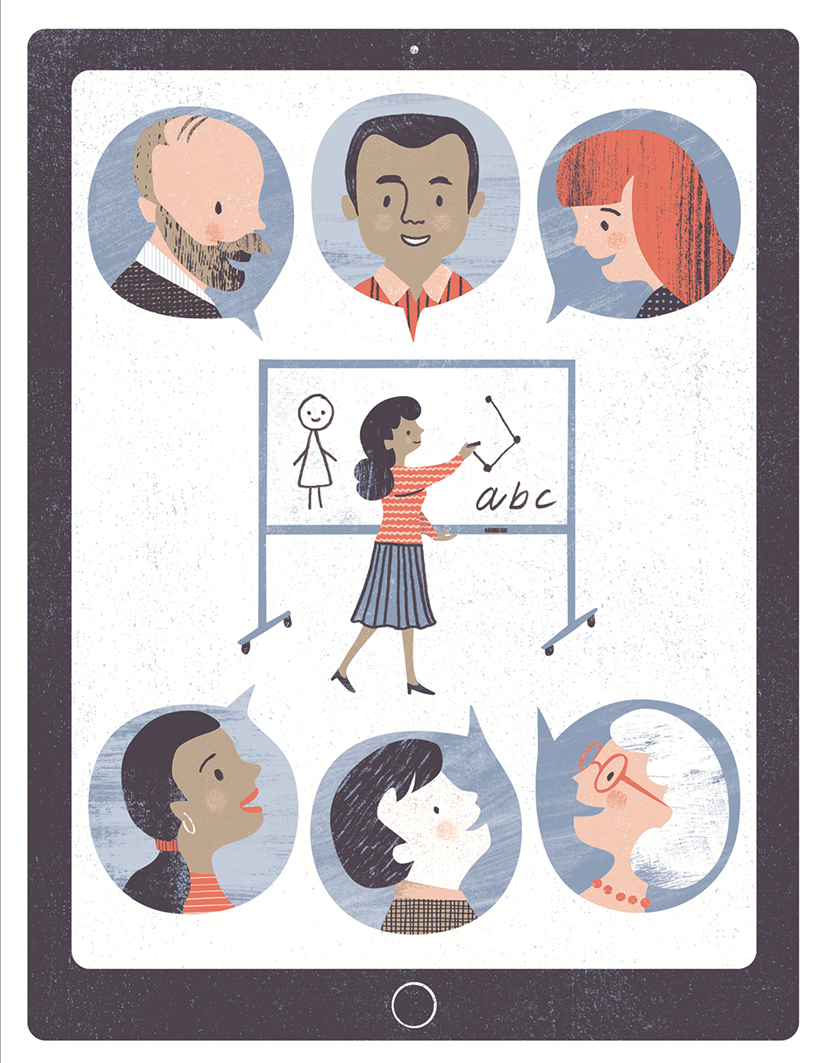
Collaborating via Facebook
The Facebook group NZ Teachers (Primary) is the profession’s most popular online community, with more than 35,000 members.
The group was established over four years ago, the brainchild of Amber Mattsson, a teacher returning to the classroom from maternity leave and looking for advice from ordinary teachers.
“I looked online to see if there was a teachers’ forum where I might find answers. There were none, so I decided I would set up one myself.”
Mattsson set up the group with the help of her friends and colleagues, Rachael Fullard and Janine Baker, and rapidly grew membership and engagement. It is now a lively place for the exchange of advice and professional discussion.
“I think it works because teachers are natural collaborators who look for ways to help their students.”
Amber Mattsson
“I think it works because teachers are natural collaborators who look for ways to help their students,” says Mattsson. “We do that every day in the staffroom, and this online space has made it possible to share with a wider community. It has opened up the staffroom.”
Every day the Facebook page is alive with exchanges of advice and resources. Teachers who are looking to teach a new topic or age group seek out help from others – and invariably get it.
“That was our aim,” says Mattsson. “We wanted to build an online community where teachers could help each other out. Teaching’s tough enough without having to reinvent the wheel all the time. If someone has already successfully done something, why not draw on their expertise, rather than try to go it alone?”
“Often the advice sought is about how to cater for the needs of a particular child,” says Fullard. “A teacher may be looking for ways to extend a particularly gifted student, or they may have exhausted their own strategies to assist a child struggling to make progress in reading. A quick post on the Facebook page will bring a flood of suggestions and resources.”
Requests for advice also come from those seeking out professional learning and development, or looking to teach overseas. Invariably, others share experience and helpful information.
Professional and industrial discussions are often lively, often spilling over from the online space into staffrooms. “We often hear that something being discussed on the NZ Teachers Facebook page has led to an interesting discussion in schools,” says Mattsson. “There’s always a richness of ideas online.”
It’s a supportive space, too. When schools are impacted by tragedy or trauma, the community comes together.
“The [Facebook] page has brought together people who would never normally interact with each other. They’re growing understanding of people living and working in different contexts.”
Rachael Fullard
“We’re there for each other,” says Fullard. “The page has brought together people who would never normally interact with each other. They’re growing understanding of people living and working in different contexts.”
Over the past few years, the three founders have remained committed to their original intention, making a safe place where teachers can share. Members are expected to treat each other with the same kindness and respect they would use in their staffroom, and it is members who decide the direction of discussion.
“We don’t drive the content,” says Mattsson. “Sometimes there is stuff being posted that we don’t agree with, but we leave it to the individual person to take responsibility. We just supply the forum.”
The page is moderated, though, and efforts are made to minimise buying and selling or advertising. The administrators don’t want it clogged up with commercialism.
“We are really proud of what we’ve achieved,” says Amber. “It is a lot of work, especially for full-time teachers and mums, but we feel great about what we are able to contribute.”
1. She is now Deputy Principal, Senior School at Takanini School.
